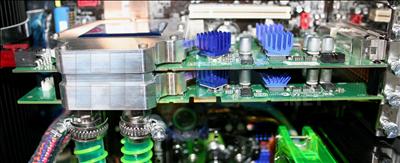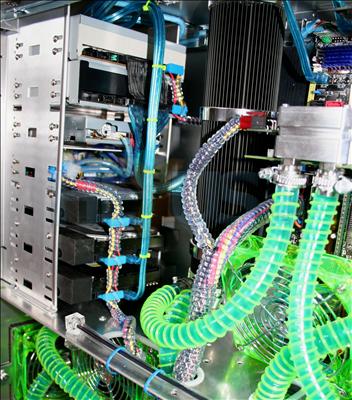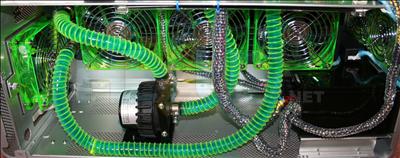Internals, warranty, bundle, thoughts

Starting at the bottom and working our way up, Vadim uses an Enermax Liberty 620W PSU to provide the power to the system. It's quiet, effective, and due to being modular, easy to connect. Vadim then installs a high-end watercooling setup to keep the Core 2 Duo E6700 and NVIDIA GeForce 7950 GX2 ticking along in heavily overclocked states.
Not strictly working in this order, a Swiftech MCP655 pump pushes the liquid, housed in UV-reactive cabling for the ultimate bling factor, to the large, tube-like reservoir mounted in the main section. The liquid is then pumped to the GeForce 7950 GX2 1GiB' block, which sits just below (upside-down, remember) a Creative X-Fi XtremeMusic soundcard.

Default-clocked and air-cooled GX2's operate at 500MHz core and 1200MHz memory. By using better cooling, thanks to the LiquoCool Antarctic, Vadim has been able to raise frequencies to 600MHz core and 1600MHz memory, making it substantially faster than a regular card. Vadim could have made another choice here and opted to run with a couple of ATI X1900 cards in CrossFire mode. Concurrently cooling them, however, would be rather tricky.
Ensuring that the resulting warmer liquid isn't then channeled directly to the CPU, a smaller radiator, cooled by another 120mm fan, is added between these two hot-running components. The tubing then winds its way to the Core 2 Duo E6700 CPU that is overclocked from its native 2.67GHz to 3.40GHz, which, due to the multiplier-locked (upwards) nature of non-Extreme processors, dictates a 340MHz FSB. We'd like to have seen a Core 2 Extreme used, but that would push pricing up by another �350 or so. Gaining this extra speed comes at the cost of increased voltage. The motherboard is set up with VCore at, frankly, an alarming 1.6625V, which falls to around 1.62V under load. The extensive cooling can keep the CPU, under load, at <55C, but, considering a default voltage of around 1.3V, we worry about its longevity. We must note that the system remained rock-solid during a week of testing, though.
An ASUS P5W DH Core 2 Duo-supporting motherboard is used, and its feature-rich design and proven overclockability makes it a decent choice. However, we'd like to see Vadim also liquid cool the chipset's northbridge. As it is, the motherboard's noisy 40mm fan is left to do the job.
Keeping up the high-performance theme is the inclusion of 2GiB (2 x 1GiB) PC8000-rated DDR2 modules from OCZ. The Platinum EL XTC dual-channel series is specified to run at DDR2-1000 speeds with 5-5-5-15 latencies and with 2.1V. Vadim, though, raises voltage to 2.2V and lowers latencies to an impressive 4-4-4-14 at 1020MHz. Responsibly, another 120mm fan is added and positioned directly in front of the DIMMs, blowing cool-ish air over the sticks.

A look at the hard drives shows ultra-tidy cable management and vibration-reducing mounts. The boot drives, which are two Seagate 7200.10 drives configured in RAID0, offer speedy OS loading. A 250GB Western Digital drive is further added for storage. We'd liked to have seen three 320GB drives in the system, especially if you consider the small pricing differential between 250GB and 320GB models. Should you wish to add extra drives you will have to remove one of the components pre-fitted in to the 5.25" bays. The bottom compartment is usually home to a 12-bay hard-drive rack, but Vadim has removed that to house the watercooling apparatus. More blingness (such a horrible word?) is added by the UV cold cathode that shines on the Tygon tubing

Coming back to cooling again, the warm liquid from the CPU block is then pushed down to the giant radiator. It's cooled by 3 120mm fans that are all controlled, together, by the Innovatek controller on the front, so any increases in fan speed will affect all three. A 120mm intake fan, at the very front, again controlled by the Innovatek Fan-O-Matic, pulls in external (cooler) air and drives it across the radiator. A couple of smaller 80mm fans exhaust warm air. Once the liquid has passed through it's driven by the pump and back up to the reservoir, to complete another loop. We also reckon that the aluminium Lian Li chassis helps cooling somewhat, acting like a giant heatsink. The sides certainly became warm when the system was under load.
Noise
You'd imagine that a PC that packs in 8 fans in additional to the PSU's would be noisy. The use of high-quality fans and the Innovatek Fan-O-Meter, which regulates fan-speed to 1,200RPM in most cases, actually makes for a quiet PC. In the realm of ultra-fast, benchmark-bashing base units we've seen recently, Vadim's is probably the quietest. That's a definite bonus when speed is the primary concern.Accessories
Vadim ships this SKU with a high-quality aluminium Enermax keyboard that complements the system well. The system also ships with Windows XP Home SP2 and DVD playback software that bundled with the optical drives. The ASUS P5W DH motherboard provides integrated WiFi and ships with a remote control that controls the PC's basic functions. Additional software is to be confirmed.Power and heat
Using a basic watt meter, the Vadim Fusion Cetus pulled (off the mains) 290W when idling in Windows and around 385W when running looping iterations of our Splinter Cell: Chaos Theory benchmark. The use of a high-quality PSU from Enermax, which claims 80% wide-load efficiency, helps keep the overall wattage requirement down.In terms of heat, and using an infrared thermometer, we measured the GPU block to be running at 55C when under load (and side window open. Further, the top of the chassis, close to the GPU block, was reckoned to be at 42C, or 15C above ambient, lending weight to its excellent heat-dissipation properties. Finally, the 80mm exhaust fan temperature was measured at 37C and the PSU's at 45C. A warm system, yes, but well within normal working parameters.
Warranty and support
Included in the �2,500 (ex-VAT) asking price is Vadim's Premium warranty. Sounds good, doesn't it? However, on closer inspection a Premium warranty is rather limited. Firstly, it's only 2 years and we expect a machine of this cost to be backed up by a 3-year warranty, even if that entails a slightly higher asking price. What's more worrying is the fact that delivery costs, should the system need to be returned to Vadim and transported back to you, fall on the buyer's shoulders. We're rather nonplussed by that. However, if Vadim PC diagnoses the fault as minor, say, the need for new RAM, and the user is experienced enough to remove and fit it themselves, Vadim will courier the new part and take back the faulty item at no extra cost.Upgrading to a Deluxe warranty for the same period costs a further �128 (inc. VAT). If any problems are diagnosed as minor, Vadim will send out an engineer for a home visit. More serious problems will require the system to be shipped back to Vadim's HQ in London, at no extra charge to the customer. Further, upgrading the standard Premium warranty up to a 3-year Deluxe will cost �213. If you're paying by credit card a 1.9% additional charge will be incurred.
You, the reader, needs to bear these additional costs in mind when gauging overall value. We must also note that the warranty isn't backed up by third-party insurance. Vadim PC can be contacted via a local-rate (0845) phone number and its website has a live chat feature for immediate responses.
Vadim also offers the customer a couple of delivery options. For a reasonable �23.50 including VAT you can have it shipped via CityLink. However, if you're in a real need and simply cannot wait, Vadim also offers a same-day TNT service for �69 inc. VAT. The Express Fragile service takes particular note of how Vadim wants the system shipped (on one side, standing up, etc) and, as noted, is delivered on the same day as it's dispatched. Taking the Express Build service into account, we reckon that you can have the system in your possession about a week after the order is placed. Vadim also informs us that this SKU will start shipping immediately.
Value for money?
Can a near-�3k base unit ever be considered value for money? What we can say is that Vadim has chosen a sensible mix of high-end components and combined them with excellent build quality and care that only enthusiast companies seem to have. You can, of course, build it cheaper yourself, yet, we feel, there's a definite niche market for users who want the fastest possible PC but don't have the time/inclination to build it themselves. In that case, then, Vadim's asking price can be considered just about reasonable for the specification.We'd make changes to the build, as listed above, but, in the main, it's good. It's worth noting, though, that MESH is shipping a system with a non-overclocked Intel Core 2 Duo Extreme CPU, twin GeForce 7900 GTX cards in SLI, Creative 7900 speakers, and a 20-inch TFT for �2,499 inc. VAT. Of course, there's no fancy case, custom cooling or overclocking, but it shows what a larger S.I. can produce at a lower price-point.
Potential buyers will probably add a 24-inch WUXGA TFT, high-quality speakers and peripherals. That'll leave you scant change from �4,000, which is more than this poor reviewer's car is worth. Power in spades, yes, but they're expensive spades.









